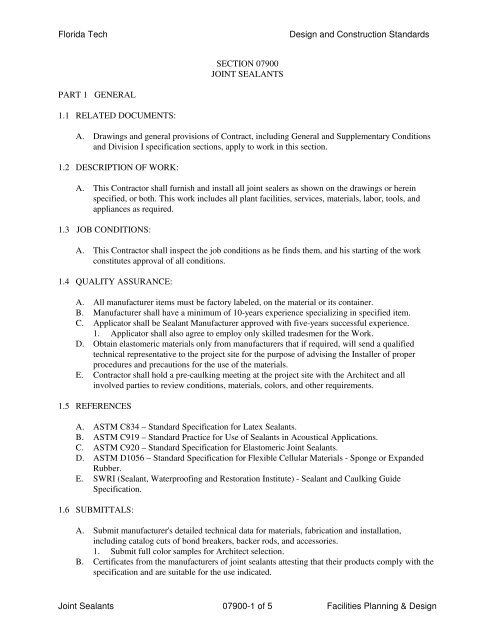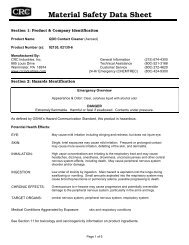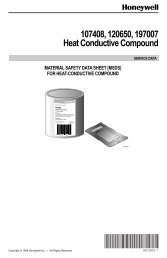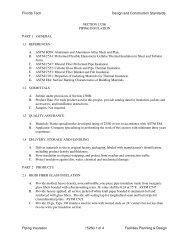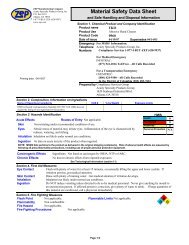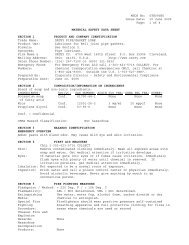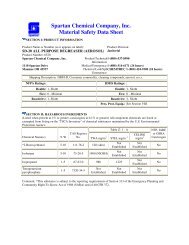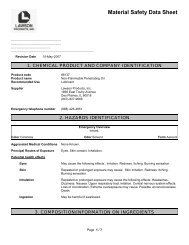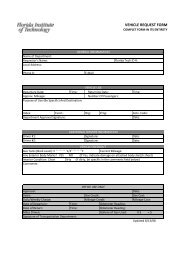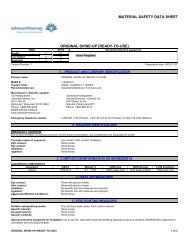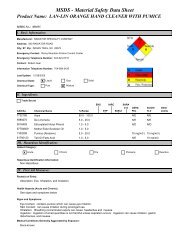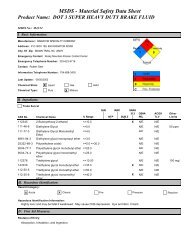Section 07900 Joint Sealants
Section 07900 Joint Sealants
Section 07900 Joint Sealants
You also want an ePaper? Increase the reach of your titles
YUMPU automatically turns print PDFs into web optimized ePapers that Google loves.
Florida Tech<br />
Design and Construction Standards<br />
SECTION <strong>07900</strong><br />
JOINT SEALANTS<br />
PART 1 GENERAL<br />
1.1 RELATED DOCUMENTS:<br />
A. Drawings and general provisions of Contract, including General and Supplementary Conditions<br />
and Division I specification sections, apply to work in this section.<br />
1.2 DESCRIPTION OF WORK:<br />
A. This Contractor shall furnish and install all joint sealers as shown on the drawings or herein<br />
specified, or both. This work includes all plant facilities, services, materials, labor, tools, and<br />
appliances as required.<br />
1.3 JOB CONDITIONS:<br />
A. This Contractor shall inspect the job conditions as he finds them, and his starting of the work<br />
constitutes approval of all conditions.<br />
1.4 QUALITY ASSURANCE:<br />
A. All manufacturer items must be factory labeled, on the material or its container.<br />
B. Manufacturer shall have a minimum of 10-years experience specializing in specified item.<br />
C. Applicator shall be Sealant Manufacturer approved with five-years successful experience.<br />
1. Applicator shall also agree to employ only skilled tradesmen for the Work.<br />
D. Obtain elastomeric materials only from manufacturers that if required, will send a qualified<br />
technical representative to the project site for the purpose of advising the Installer of proper<br />
procedures and precautions for the use of the materials.<br />
E. Contractor shall hold a pre-caulking meeting at the project site with the Architect and all<br />
involved parties to review conditions, materials, colors, and other requirements.<br />
1.5 REFERENCES<br />
A. ASTM C834 – Standard Specification for Latex <strong>Sealants</strong>.<br />
B. ASTM C919 – Standard Practice for Use of <strong>Sealants</strong> in Acoustical Applications.<br />
C. ASTM C920 – Standard Specification for Elastomeric <strong>Joint</strong> <strong>Sealants</strong>.<br />
D. ASTM D1056 – Standard Specification for Flexible Cellular Materials - Sponge or Expanded<br />
Rubber.<br />
E. SWRI (Sealant, Waterproofing and Restoration Institute) - Sealant and Caulking Guide<br />
Specification.<br />
1.6 SUBMITTALS:<br />
A. Submit manufacturer's detailed technical data for materials, fabrication and installation,<br />
including catalog cuts of bond breakers, backer rods, and accessories.<br />
1. Submit full color samples for Architect selection.<br />
B. Certificates from the manufacturers of joint sealants attesting that their products comply with the<br />
specification and are suitable for the use indicated.<br />
<strong>Joint</strong> <strong>Sealants</strong> <strong>07900</strong>-1 of 5 Facilities Planning & Design
Florida Tech<br />
Design and Construction Standards<br />
1.7 DELIVERY, STORAGE, AND HANDLING<br />
A. Deliver materials to the project site in original unopened containers or bundles with labels<br />
indicating manufacturer, product name and designation, color, expiration period for use, pot life,<br />
curing time, and mixing instructions for multi-component materials.<br />
B. Store and handle materials in compliance with manufacturer’s requirements to prevent their<br />
deterioration or damage due to moisture, temperature, contaminants, or other causes.<br />
1.8 WARRANTY<br />
A. The Contractor shall furnish written guarantee that work executed under this section is free from<br />
defects of material and workmanship for a period of five-years from date of substantial<br />
completion of the entire project.<br />
1. Include coverage that he will, without delay and at his own expense repair and replace all<br />
such defects as may develop during the term of this guarantee.<br />
PART 2 PRODUCTS<br />
2.1 MANUFACTURERS<br />
A. Manufacturers: Subject to compliance with the requirements, provide products by one on the<br />
following:<br />
1. DAP, Inc., Dayton, Ohio<br />
2. Dow Corning Corp., Midland, Michigan<br />
3. General Electric Co., GE Silicones, Waterford, New York<br />
4. Mameco International, Inc., Cleveland, Ohio<br />
5. Pecora Corp., Harleysville, Pennsylvania<br />
6. Rhone-Poulenc, Inc., Plymount, New Jersey<br />
7. Sonneborn Building Products Div., Minneapolis, Minnesota<br />
8. Tremco, Inc., Beachwood, Ohio<br />
9. Hilti Construction Chemicals, Tulsa, Oklahoma<br />
B. Contractor may request other products or manufacturers for acceptance provided they equal or<br />
exceed the material requirements and functional qualities of the specified product.<br />
1. The "Substitution Request Form" and complete technical data for evaluation must<br />
accompany requests for Architect's approval.<br />
2. All materials for evaluation must be received at least 10-days prior to bid due date.<br />
3. Additional approved manufacturers will be issued by Addendum.<br />
2.2 MATERIALS<br />
A. General<br />
1. The term “Acceptable Standard” when used within this <strong>Section</strong>, refers to the manufacturer<br />
and product listed, specified as to type and quality required for this project.<br />
2. Single resource responsibility for joint sealer materials: Obtain joint sealer materials from a<br />
single manufacturer for each different product required.<br />
3. Compatibility: Provide joint sealers, joint fillers, and other related materials that are<br />
compatible with one another and with joint substrates under conditions of service and<br />
application, as demonstrated by sealant manufacturer based on testing and final experience.<br />
B. Caulking Compounds (Acrylic Latex Sealant)<br />
<strong>Joint</strong> <strong>Sealants</strong> <strong>07900</strong>-2 of 5 Facilities Planning & Design
Florida Tech<br />
Design and Construction Standards<br />
1. Latex rubber modified, acrylic emulsion polymer sealant compound; manufacturer’s<br />
standard, one part, non-sag, mildew resistant, acrylic emulsion sealant complying with<br />
ASTM C 834, formulated to be painted and recommended for exposed applications on<br />
interior locations involving joint movement of not more than plus or minus 5%.<br />
2. Acceptable Standard<br />
a. “Sonolac”; Sonneborn Building Products, Inc.<br />
b. “Acrylic Latex Caulk 832”; Tremco, Inc.<br />
c. “Acrylic Latex Caulk with Silicone”; DAP<br />
d. “AC-20”; Pecora Corp.<br />
C. One-Part Elastomeric Sealant (Silicone)<br />
1. One component elastomeric sealant complying with ASTM C 920, Class 25, Type NS (nonsag),<br />
unless manufacturer recommends Type S (self-leveling) for the application shown.<br />
a. Acceptable Standard<br />
i) “Pecora 864 Architectural Silicone Sealant; Pecora Corp.<br />
ii) “Dow Corning 791; Dow Corning Corp.<br />
iii) “Silpruf”: General Electric<br />
iv) “Omniseal”; Sonneborn Building Products, Inc.<br />
v) “Spectrem 2; Tremco Mtg. Co.<br />
2. One component mildew resistant silicone sealant (around countertops and backsplashes and<br />
other wet interior locations.)<br />
a. Acceptable Standard<br />
i) “Rhodorsil 6B White”; Rhone-Poulenc, Inc.<br />
ii) “Dow Corning 786”, Dow Corning Corp.<br />
iii) “Sanitary 1700”; General Electric<br />
3. One-component high movement joints (+100/-50): Where locations of high movement are<br />
indicated.<br />
a. “Dow Corning 790”; Dow Corning Corp.<br />
b. “Spectrem 1”; Tremco<br />
D. Elastomeric Sealant (Polyurethane)<br />
1. One component polyurethane sealant, complying with ASTM C 920, Type S, Grade NS,<br />
Class 25 (non-sag).<br />
a. Acceptable Standard<br />
i) “Sonolastic NP 2”; Sonneborn Building Products, Inc.<br />
ii) “Dymonic”: Tremco Mfg. Co.<br />
iii) “Dynatrol I”; Pecora Corp.<br />
iv) “Vulkem 921”; Mameco<br />
v) “CS 2130”; Hilti<br />
2. Two component polyurethane sealant, complying with ASTM C920, Type M, Grade NS,<br />
Class 25 (non-sag).<br />
a. Acceptable Standard<br />
i) “Sonolastic NP 2” Sonneborn Building Products, Inc.<br />
ii) “Dymeric 511”; Tremco Mfg. Co.<br />
iii) “Dynatrol II”; Pecora Corp.<br />
iv) “Vulkem 922”; Mameco<br />
E. One-part self-leveling polyurethane sealant (for traffic areas)<br />
1. One component polyurethane self-leveling sealant, complying with ASTM C 920, Type S,<br />
Grade P, Class 25.<br />
a. Acceptable Standard<br />
i) “Sonolastic SL 1”; Sonneborn Building Products, Inc.<br />
ii) “NR-201 Urexpan”; Pecora Corp.<br />
<strong>Joint</strong> <strong>Sealants</strong> <strong>07900</strong>-3 of 5 Facilities Planning & Design
Florida Tech<br />
Design and Construction Standards<br />
iii) “Vulkem 45”; Mameco<br />
2. Two component polyurethane self-leveling sealant, complying with ASTM C920, Type M,<br />
Grade P, Class 25.<br />
a. Acceptable Standard<br />
i) “Sonolaastic SL 2”; Sonneborn Building Products, Inc.<br />
ii) “NR-200 Urexpan”: Pecora Corp.<br />
iii) “Vulkem 245”; Mameco<br />
iv) “THC900/THC901”: Tremco<br />
F. Security Sealant (Polyurethane)<br />
1. One component or two component polyurethane sealant, complying with ASTM C 920,<br />
Grade NS, Class 12.5 with a Shore A Hardness of 55.<br />
a. Acceptable Standard<br />
i) “Dynaflex”, Pecora Corp.<br />
ii) “Ultra”, Sonneborn Building Products, Inc.<br />
G. Miscellaneous Materials<br />
1. Provide joint cleaner and joint primer sealer as recommended by the sealant or caulking<br />
compound manufacturer.<br />
2. Sealant backer rod shall be compressible rod stock, polyethylene foam, polyethylene<br />
jacketed polyurethane foam, butyl rubber foam, neoprene foam, or other materials as<br />
recommended by sealant manufacturer.<br />
a. Where a 2" building expansion joint is indicated, provide a expanding foam secondary<br />
sealant, “BackerSeal” as manufactured by Emseal <strong>Joint</strong> Systems, Ltd., Westborough,<br />
MA or Apolytite Standard @ as manufactured by Polytite Manufacturing Corporation,<br />
Cambridge, MA, behind sealant in lieu of standard backer rod.<br />
3. Primer: Provide type recommended by joint sealer manufacturer where required for<br />
adhesion of sealant to joint substrates indicated, as determined from preconstruction joint<br />
sealer substrate tests and field tests.<br />
4. Cleaners for Nonporous Surfaces: Provide non-staining, chemical cleaners of type which<br />
are acceptable to manufacturers of sealants and sealant backing materials, which are not<br />
harmful to substrates and adjacent nonporous materials, and which do not leave oily<br />
residues or otherwise have a detrimental effect on sealant adhesion or in service<br />
performance.<br />
5. Masking Tape: Provide non-staining, non-absorbent type compatible with joint sealants and<br />
to surfaces adjacent to joints.<br />
PART 3 EXECUTIONS<br />
3.1 INSPECTION:<br />
A. This Contractor shall notify the General Contractor, when he has completed his work and is<br />
ready for A/E inspection.<br />
B. Verify that substrate surfaces and joint openings are ready to receive work.<br />
C. Verify that joint backing and release tapes are compatible with sealant.<br />
D. Clean and prime joints in accordance with manufacturer’s instructions.<br />
E. Remove loose materials and foreign matter that might impair adhesion of sealant.<br />
3.2 INSTALLATION:<br />
A. All products shall be installed in strict accordance to all manufacturer's recommendations.<br />
B. Measure joint dimensions and size materials to achieve required width/depth ratios.<br />
<strong>Joint</strong> <strong>Sealants</strong> <strong>07900</strong>-4 of 5 Facilities Planning & Design
Florida Tech<br />
Design and Construction Standards<br />
C. Install joint backing to achieve a neck dimension no greater than 1/3 the joint width.<br />
D. Install bond breaker where joint backing is not used.<br />
E. Install sealant free of air pockets, foreign embedded matter, ridges, and sags.<br />
F. Apply sealant within recommended application temperature ranges. Consult manufacturer when<br />
sealant cannot be applied within these temperature ranges.<br />
G. Tool joints concave.<br />
3.3 ADJUSTMENT AND CLEANING:<br />
A. After installation, all exposed surfaces shall be thoroughly cleaned, and all damaged material<br />
shall be restored to its original condition, or replaced with new material.<br />
END OF SECTION<br />
<strong>Joint</strong> <strong>Sealants</strong> <strong>07900</strong>-5 of 5 Facilities Planning & Design


